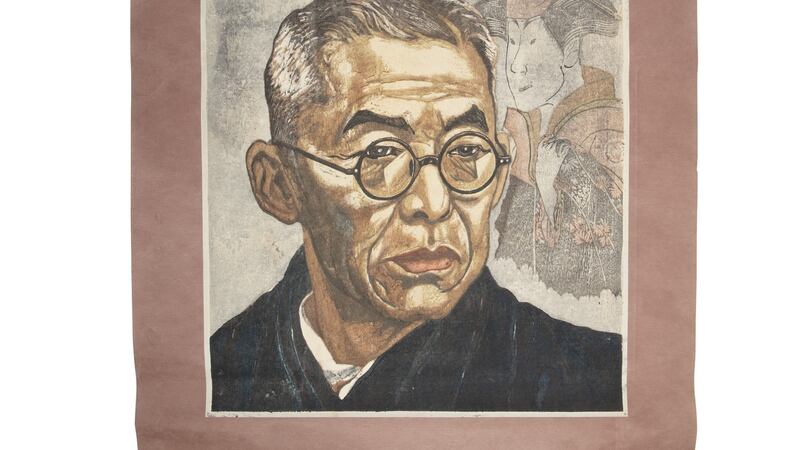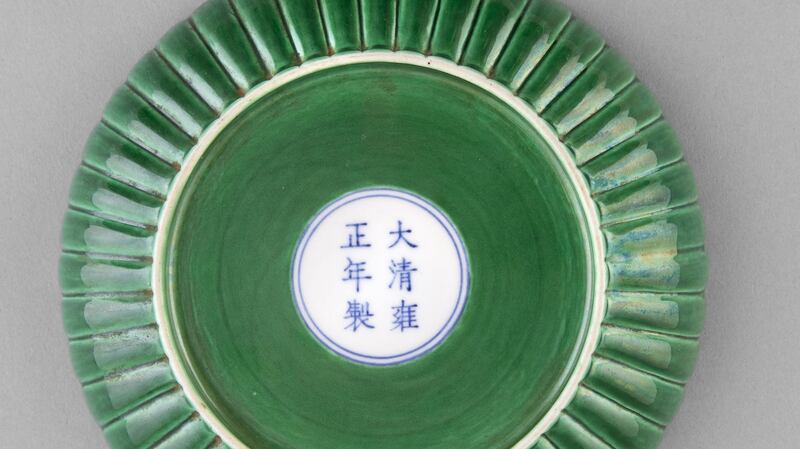It’s fair to say that Western gardeners don’t pay much attention to the humble chrysanthemum. In Chinese culture the plant has fared rather differently. Inspired by its ability to resist winter chills, Chinese emperors drank wines laced with chrysanthemum, poets praised what they called “the petals of longevity”, and the intricate forms of chrysanthemum flowers came to figure prominently in Chinese art.
Symbolically the flower is associated with long life, good fortune and the season of autumn, so it’s appropriate that the most expensive piece in Adam’s first-ever specialist auction of Fine Oriental Ceramics, Sculpture and Art is a green “chrysanthemum dish” (Lot 74, €40,000-€60,000).
Why such a high estimate for such a tiny dish?
“It dates from the Yongzheng period, which was quite a short one, 1723 to 1735, and porcelain from that time is known for its high technical quality,” says Ronan Flanagan of Adam’s fine art department. “Porcelains were moving away from blue and white, and coloured glazes were the order of the day. The chrysanthemum dishes are well known to the market, and highly collectible.”
The dish comes from the Carlow Collection, which was assembled in Philadelphia during the 1940s by two sisters who returned with it to Ireland. Although items of oriental art often feature in Irish auctions, especially country house auctions, specialist sales are still rare here. How did Flanagan go about putting this one together?
“The contents of the auction have come to us from scattered locations all around the country,” he says. “Some really good quality lots were consigned to begin with, and that was a very good centre point from which to build an interesting auction.

“The sale consists of various strains of artwork, including porcelains, rugs, silver, jades and paintings. Although the majority of the works are Chinese, we have a very decorative section of Japanese works and some very early central Asian ceramics.”
There has been strong advance interest in the sale, with many people registering to bid from the UK and Asia, says Flanagan. These include investors who are carefully selecting pieces of Chinese and other oriental art for pensions or profit.
Storage jar
One of the more remarkable objects in the sale is Lot 76 (€10,000-€15,000), a stoneware storage jar in the form of an owl. If this rare bird looks somewhat primitive that could be because she is very, very old. As confirmed by a thermoluminescence test carried out in Vienna in 2004, the piece dates from the Warring States period, making it almost 2,500 years old.
“It’s in superb condition, most likely due to the protection it was afforded by burial,” says Flanagan. “This was likely filled with wine and carefully placed in a tomb.”
Flanagan began working with antiques in 1994. “There were some fascinating stories in circulation at that time about how inconspicuous oriental items had realised substantial amounts at auction. It was very intriguing, and curiosity drew me in. Why were these pieces so highly prized, and what made them so special to a collector?”
At that time there weren’t many people who had an in-depth knowledge on the subject. He became friendly with an old retired Oriental dealer from Germany, Rudi Holzapfel, who would call into the saleroom each Monday and teach him about the various items. “It’s still a work in progress. I’m still learning.”
His advice to anybody who is thinking of dipping a toe into the Asian art market is to start with regular visits to Collins Barracks and the Chester Beatty Library, both of which have good oriental collections. Then visit auction rooms and handle the items to become familiar with how they feel in the hand and look to the eye. “You will develop a physical knowledge through handling that you cannot find in any book.”

The present auction ranges widely in terms of subject matter, price level and historical period. Lot 89 (€2,000-€3,000) is an 18th century copper foot warmer; Lot 184 (€800-€1,200) a white metal cocktail set from 1925; Lot 224 (€200-€300) is a set of four framed photographs which depict, in no-holds-barred detail, executions from the time of the Boxer rebellion.
Sparrow vase
Among the Japanese items, a sparrow vase (Lot 261, €4,000-€6,000) in midnight blue enamel has an elegant elongated shape, while there is a good, and modestly-priced, selection of woodblock prints from a collection assembled in Japan in the 1930s. Lot 311 (€600-€800) is a beautifully-coloured snow scene; Lot 289 (€300-€500) is a striking portrait of the kabuki actor Nakamura Kichiemon.
Porcelain bowls, jars, bottles and vases are among the most beautiful items in the auction. There are many “blue and white” pieces to choose from. Peonies and lotus flowers weave their way around a rare 14th century jar (Lot 27 €30,000-€50,000); scholars walking along mountain paths adorn a Ming dynasty square bottle (Lot 124 €1,000-€2,000).
For multicoloured virtuosity it would be hard to beat Lot 93 (€20,000-€30,000). A large cloisonne enamel fish basin decorated on the outside with a mountain scene featuring deer, cranes and peach trees, the interior is filled with fish swimming among reeds and aquatic plants: a toy, as Prof Alan J Fletcher writes in a catalogue note quoting WB Yeats, “to keep a drowsy emperor awake”.
At the simpler end of the spectrum a pair of pear-shaped vases in a warm coppery red (Lot 75 €4,000-€6,000) have a timeless shape which would complement any style of interior.
See adams.ie











